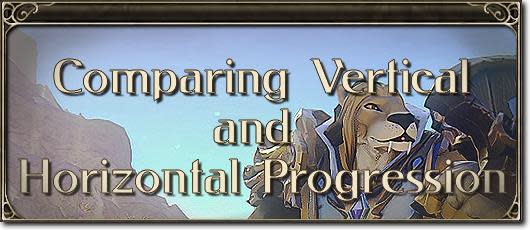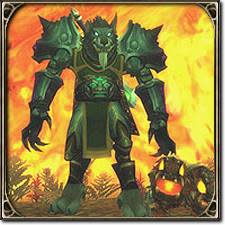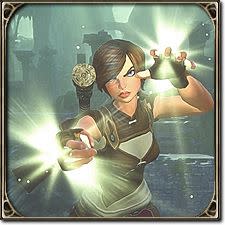MMO Mechanics: Comparing vertical and horizontal progression
MMO players strive to obtain some kind of tangible progression each play session, but the method by which that progression is delivered varies greatly across the genre. Archetypal themepark titles frequently rely on level-based progression that culminates in climbing through gear tiers at endgame, but the freeform nature of sandbox MMOs lends itself to a more open progression system that focuses on the holistic development of characters. These two progression systems are described as vertical and horizontal progression: Traditional gearing or leveling is commonly described as a vertical climb, while wider choice-based progression is more often expressed as a non-linear journey.
The relative merits of these two diverging approaches to progression are commonly debated by modern MMO players. Many players wish to see a blended hybrid approach to progression that emphasises the horizontal, multi-faceted growth of their characters over rattling through yet another gear tier. Despite this, players still favour a goal-oriented attainment system and perhaps progressive gear that doesn't require a long run on the grinding treadmill. This balance can be very hard to achieve, so titles such as Guild Wars 2 have taken some knocks on the path towards perfect horizontal and vertical progression balance.
In this week's MMO Mechanics, I will look at what is meant by both vertical and horizontal progression, how they are mechanically implemented in MMOs, and what each type of progression means for the playerbase.
The vertical climb: Leveling and gearing mechanics
Equipment is the main endgame marker of progression in the bulk of themepark MMOs. We all know the scenario: Level up a character, run current content, gain a new tier of gear for your efforts, and repeat again for the next tier or expansion. This progression mechanic is typified in World of Warcraft, which set the bar for the overarching direction of themepark MMOs due to its massive success. Vertical progression places an emphasis in strengthening the equipment at your disposal rather than applying the equipment differently or using alternative gear or abilities to succeed at various scenarios.
This presents some important advantages to both players and developers. New players find that vertical progression presents them with a little bit of simplicity in the complicated world of MMOs, which serves to make the game more accessible. Too much choice can pair with themepark theorycrafting to create a steep learning curve, so certain types of player prefer vertical progression that allows effort to be rewarded without too much skill. Since most players will only focus on content that secures progressive rewards, developers can focus their time on key endgame content without alienating the playerbase.
Although I can see some merits to vertical progression, it's quite odd and counterintuitive to aim for shiny new equipment instead of advanced skills, attributes, or other more permanent enhancements. I find that a player's skill can be masked by handing his character better gear, and I have seen skilled players miss out on raiding spots due to their lack of top gear pieces. Gear-based vertical progression also has the undesirable side-effect of rendering older content useless by eliminating its inherent challenge for those who are over-geared for the zone. Players who are late to the MMO party will miss out on great content and lore as older players are discouraged from playing alongside ill-geared friends. Power creep doesn't just make content obsolete: The gear that accompanied that older content becomes just as worthless.
Horizontal progression
Horizontal game mechanics make players think outside of the confines of linear progression as the games that employ them offer elements that actively cater to individualistic strategy building. Rather than equipping characters to face the latest content the MMO world can throw at them, horizontal mechanics point towards the development of a wide range of character attributes that will weather any challenges that lie ahead. Each ability isn't inherently better than another, but well-researched combinations might create a much more powerful effect. The key here is to expand the pool of items, abilities, and systems that are useful and interesting during the endgame.
Horizontal mechanics, normally equated with sandbox MMOs, faced a decline when WoW's phenomenal success caused an explosion of clones to wash across the genre. The vertical progression mechanics offered by Blizzard presented players with a popular lower barrier to entry and the company's competitors adopted a formulaic approach to themepark MMO creation. However, vertical progression can also create an all-too linear experience that makes progress feel compulsory and one-dimensional. The choices presented to players don't ultimately matter, and characters will be equipped with whichever items best boost their key stats.
The future for progression mechanics
New MMOs on the horizon are planning on resurrecting horizontal progression mechanics to recreate an open experience that doesn't present players with an indomitable grind; EverQuest Next's developers have talked about a broad-stroke approach to the title's progression mechanics that puts the player in control. This outlook tackles the issue of obsolete equipment and the never-ending grind for best-in-slot gear. It also allows players to adapt their characters to various challenges or gameplay styles in unique ways while simultaneously reducing the gear grind.
This multifaceted approach to progression diminishes bracketing by level or gear, levels the playing field by making progress feel skill-based instead of gear-based, and keeps content more relevant for players across the board. Players would be encouraged to collect a variety of equipment to suit certain situations, like frost armour to protect an adventurer from dragon breath, for example, rather than simply selecting the gear with the best stats.
Climbing the progression ladder can prevent the players at the top from interacting with those who remain on a lower rung, but if this progression is made into more of a journey than an ascent, then players can derive much more fun from the process and can interact with anyone or any content along the way. Vertical progression can present a barrier to successful exploration of high-end content like endgame raids and PvP, since many guilds or groups will not tolerate a lack of current gear. Newer titles like Guild Wars 2 have done much to reduce the modern era's endgame gear grind, and I hope yet more others will further adopt timeless horizontal mechanics to open up MMOs to suit yet more playstyles and encourage clever combinations of abilities in order to best difficult content.

MMOs are composed of many moving parts, but Massively's Tina Lauro is willing to risk industrial injury so that you can enjoy her mechanical musings. Her column, MMO Mechanics, explores the various workings behind our beloved MMOs every Wednesday.






